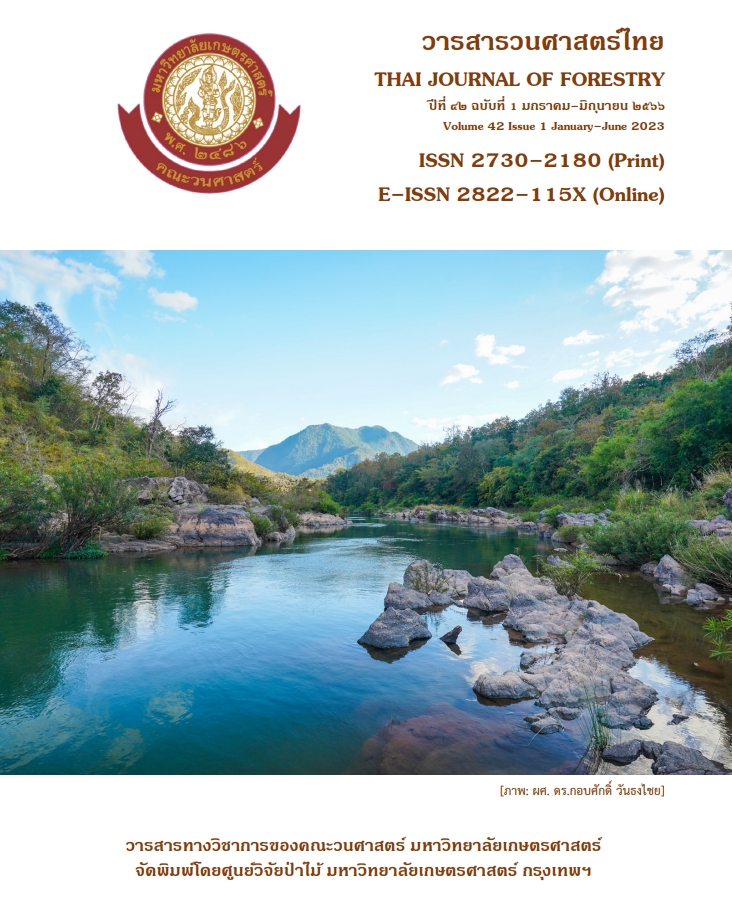คุณสมบัติทางฟิสิกส์และทางกลของไม้ยูคาลิปตัสยูโรฟิลล่าสายต้น K62
Main Article Content
บทคัดย่อ
ยูคาลิปตัสมีศักยภาพในการเป็นวัตถุดิบ สำหรับอุตสาหกรรมไม้และเส้นใย อย่างไรก็ตามยูคาลิปตัสส่วนใหญ่ใช้ในการผลิตสินค้าที่มีมูลค่าต่ำ เช่น เยื่อกระดาษ ผลิตภัณฑ์พลังงาน และไม้ประกอบสำหรับเฟอร์นิเจอร์ ยูคาลิปตัสส่วนใหญ่ไม่ค่อยแปรรูปเป็นไม้แปรรูป วัตถุประสงค์ของการวิจัยนี้ เพื่อศึกษาคุณสมบัติทางฟิสิกส์และทางกลของไม้ยูคาลิปตัสยูโรฟิลล่าสายต้น K62 เพื่อเป็นข้อมูลพื้นฐานในการนำไปใช้ประโยชน์ในลักษณะไม้แปรรูป และนำไปทำเป็นผลิตภัณฑ์ที่มีมูลค่าสูง เพื่อใช้ทำโครงสร้าง เช่น glue laminated timber (GLT) และ cross laminated timber (CLT) คุณสมบัติทางฟิสิกส์ของไม้ยูคาลิปตัสสายต้น K62 ได้แก่ ค่าความถ่วงจำเพาะที่สภาวะอบแห้งมีค่าเฉลี่ยเท่ากับ 0.63 จุดหมาด มีค่าเฉลี่ยอยู่ระหว่างร้อยละ 23 ถึง 25 การหดตัวสูงสุดทางด้านสัมผัส ทางด้านรัศมี และ ด้านความยาว มีค่าเท่ากับร้อยละ 7.50, 5.10 และ 0.02 ตามลำดับ เมื่อความชื้นลดลงจากจุดหมาดจนถึงร้อยละ 0 และ ความชื้นสมดุลย์จากการคายน้ำที่อุณหภูมิคงที่ พบว่า ความชื้นสมดุลย์มีค่าต่ำลงเมื่ออุณหภูมิเพิ่มขึ้น และที่อุณหภูมิคงที่ค่าความชื้นสมดุลย์ลดลงตามการลดลงของความชื้นสัมพัทธ์ คุณสมบัติทางกลของไม้ยูคาลิปตัสสายต้น K62 ทำการทดสอบที่ความชื้นเฉลี่ยเท่ากับ 10.75 เปอร์เซ็นต์โดยมีค่าเฉลี่ย โมดูลัสแตกหัก เท่ากับ 112.08 เมกะปาสคาล โมดูลัสหยืดหยุ่น เท่ากับ 9,213 เมกะปาสคาล แรงอัดขนานเสี้ยน เท่ากับ 55.93 เมกะปาสคาล แรงอัดตั้งฉากเสี้ยน เท่ากับ 9.68 เมกะปาสคาล ค่าความแข็ง เท่ากับ 5,875 นิวตัน แรงฉีก และ แรงยึดเหนี่ยวตาปู เท่ากับ 2.25 และ 35.34 นิวตันต่อมิลลิเมตร ตามลำดับ จากการเปรียบเทียบคุณสมบัติทางกลกับมาตราฐานไม้ที่ใช้ทำโครงสร้าง พบว่า ไม้ยูคาลิปตัสสายต้น K62 มีค่าความแข็งแรงผ่านเกณฑ์มาตรฐานการก่อสร้าง สามารถนำไปใช้ทำเป็นโครงสร้างหลักของอาคารได้ ดังนั้นจึงมีความเหมาะสมในการนำมาทำเป็นวัตถุดิบสำหรับผลิตไม้แปรรูปเพื่อทำโครงสร้าง และนำไปผลิตเป็นผลิตภัณฑ์เพื่อใช้ทำโครงสร้าง
Downloads
Article Details

อนุญาตภายใต้เงื่อนไข Creative Commons Attribution-NonCommercial-NoDerivatives 4.0 International License.
ข้าพเจ้าและผู้เขียนร่วม (ถ้ามี) ขอรับรองว่า ต้นฉบับที่เสนอมานี้ยังไม่เคยได้รับการตีพิมพ์และไม่ได้อยู่ในระหว่างกระบวนการพิจารณาตีพิมพ์ลงในวารสารหรือสิ่งตีพิมพ์อื่นใด ข้าพเจ้าและผู้เขียนร่วม (ถ้ามี) ยอมรับหลักเกณฑ์และเงื่อนไขการพิจารณาต้นฉบับ ทั้งยินยอมให้กองบรรณาธิการมีสิทธิ์พิจารณาและตรวจแก้ต้นฉบับได้ตามที่เห็นสมควร พร้อมนี้ขอมอบลิขสิทธิ์ผลงานที่ได้รับการตีพิมพ์ให้แก่วารสารวนศาสตร์ คณะวนศาสตร์ มหาวิทยาลัยเกษตรศาสตร์ กรณีมีการฟ้องร้องเรื่องการละเมิดลิขสิทธิ์เกี่ยวกับภาพ กราฟ ข้อความส่วนใดส่วนหนึ่ง หรือ ข้อคิดเห็นที่ปรากฏในผลงาน ให้เป็นความรับผิดชอบของข้าพเจ้าและผู้เขียนร่วม (ถ้ามี) แต่เพียงฝ่ายเดียว และหากข้าพเจ้าและผู้เขียนร่วม (ถ้ามี) ประสงค์ถอนบทความในระหว่างกระบวนการพิจารณาของทางวารสาร ข้าพเจ้าและผู้เขียนร่วม (ถ้ามี) ยินดีรับผิดชอบค่าใช้จ่ายทั้งหมดที่เกิดขึ้นในกระบวนการพิจารณาบทความนั้น”
เอกสารอ้างอิง
American Society for Testing and Materials (ASTM). 2014. D 143. Standard Methods of Testing Small Clear Specimens of Timber.
British Standard (BS). 1985. BS 373. Method of Testing Small Clear Specimens of Timber. British Standards Institution.
Building Control Bureau. 2021. Specification Standard of Materials Using in Building Structure. Department of Public Works and Town & Country Planning. Ministry of Interior. (in Thai)
Crafford, P.L.,Wessels, C.B. 2016. A potential new product for roof truss manufacturing: young, green finger-jointed Eucalyptus grandis lumber. Southern Forests. A Journal of Forest Science, 78(1): 61-71.
Department of Agriculture. 2005. Registration for Plant Varieties Certificate Follow Plant Varieties Act 1975. Bangkok, Thailand. (in Thai)
Department of Agriculture. 2008. Registration for Plant Varieties Certificate Follow Plant Varieties Act 1975. Bangkok, Thailand. (in Thai)
Derikvand, M., Nolan, G., Jiao, H., Kotlarewski, N. 2017. What to do with structurally low-grade wood from Australia’s plantation eucalyptus; building application?. BioResources, 12(1): 4-7.
Fredrikson, M., Thybring, E.E. 2018. Scanning or desorption isotherms? Characteristic sorption hysteresis of wood. Cellulose, 25(8): 4477-4485.
Forest Products Development Division. 2010. General Characteristics of Thai Timbers. Forest Research and Development Bureau. Royal Forest Department. Bangkok, Thailand. (in Thai)
Hanvongjirawat, W. 2016. Physical and Mechanical Properties of Eucalyptus urophylla clone K58. Thai Journal of Forestry, 35(3): 128-135.
Hanvongjirawat, W. 2022. Physical and Mechanical Properties of Eucalyptus Wood Clone K7. Thai Journal of Forestry, 41(1): 139-150.
Hua, S.L., Chen, L.W., Antov, P., Kristak, L., Tahir, P.M. 2022. Engineering wood products from Eucalyptus spp. Hindawi, 2022: 80000780. https://doi.org/10.1155/2022/8000780
Malan, F.S. 2003. The wood quality of the South African timber for high value solid wood products and its role in sustainable forestry. Southern African Forestry Journal, 198(1): 53-62, doi: 10.1080/20702620.2003.10431735
Nacar,M., Hiziroglu, S.,Kalaycioglu, H. 2005. Some of the properties of particleboard panels made from eucalyptus. American Journal of Applied Sciences, (Special Issue): 5-8.
New Nordic Timber. 2019. Engineered wood products. https://newnordictimber.com/articles/engineered-woodproducts, 13 October 2022.
Pagel, C. 2018. Investigation into Material Resistance Factors and Properties of Young, Engineered Eucalyptus Grandis Timber. M.S. Thesis, Stellenbosch University, South Africa.
Proeller, M., Nocetti, M., Brunetti, M., Barbu, M.C., Blumentritt, M., Wessels, C.B. 2018. Influence of processing parameters and wood properties on the edge gluing of green Eucalyptus grandis with a one component PUR adhesive. European Journal of Wood and Wood Products, 76: 1195–1204.
Palipane, K.B, Driscoll, R.H. 1992. Moisture sorption characteristics of inshell macadamia nuts. Journal of Food Engineering, 18: 63–76.
Panshin, A.J., de Zeeuw, C. 1980. Textbook of Wood Technology 4th ed. Mc Graw-Hill New York, USA.
Riyaphan, J. 2013. Chemmical and Mechanical Properties of Wood in Seven Para Rubber (Hevea brasiliensis Muell. Arg.) Clones. M.S. Thesis, Kasetsart University, Bangkok, Thailand. (in Thai)
Royal Forest Department. 2001. Eucalyptus Camaldulensis. Bangkok, Thailand. (in Thai)
Royal Forest Department. 2021. Forestry Statistics Data. Bangkok. Thailand. 168 p. (in Thai)
Wessels, C.B., Crafford, P.L., Du Toit, B., Grahn, T., Johansson, M., Lundqvist, S.O., Säll, H., Seifert, T. 2016. Variation in physical and mechanical properties from tree drought tolerant Eucalyptus species grown on the dry west coast of Southern Africa. European Journal of Wood and Wood Products, 74: 563-575.
Wessels, C.B., Nocetti, M., Brunetti, M., Crafford, P.L., Pröller, M., Dugmore, M.K., Pagel, C., Lenner, R., Naghizadeh, Z. 2020. Green-glued engineered products from fast growing Eucalyptus trees: A review. European Journal of Wood and Wood Products, 78(5): 933–940.
Wisuttapekul, S., Fuangwiwat, W., Sukwatnitjakul, S. 1997. Density, shrinkage and fiber saturation point of swamp forest wood. Thai Journal of Forestry, 16: 90-98. (in Thai)
Saneg-ah-tit, S. n.d. Materials testing. Major of civil engineering Institute of Engineering. Suranaree University of Technology. http://www.baannatura.com/public/files/Mpa.pdf. 12 Febuary 2015. (in Thai)
Siau, J.F. 1984. Transport Processes in Wood. Springer-Verlag Berlin Heidelberg New York Tokyo, Japan.
Skaar, C. 1972. Water in Wood. Syracue Univ Press, New York, USA.
Skaar, C. 1988. Wood-water Relations. New York. N.Y. Springer Verlag. 283 p.
Sompoch, n.d. The properties of Eucalyptus urophylla S.T. Blake. Institute of Forest Research and Development. Royal Forest Department. Bangkok, Thailand. (in Thai)
U.S. Department of Agriculture (USDA). 2021. Handbook Wood as an engineering Materials. Forest Service. Forest Products Laboratory, USA., pp. 4-1–4-22.
Yang, J.L., Waugh, G. 2001. Growth stress, its measurement and effects. Australian Forestry, 64: 127–135.
Zhou, X., Zhu, H., Wen Y., Goodale, U.M., Li, X., You, Y., Ye, D., Liang, H. 2018. Effects of understory management on trade-offs and synergies between biomass carbon stock, plant diversity and timber production in eucalyptus plantations. Forest Ecology and Management, 410: 164–173. https://doi.org/10.1016/j.foreco.2017.11.015.


